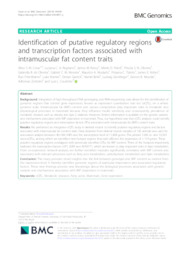Identification of putative regulatory regions and transcription factors associated with intramuscular fat content traits.
Identification of putative regulatory regions and transcription factors associated with intramuscular fat content traits.
Autoria: CESAR, A. S. M.; REGITANO, L. C. de A.; REECY, J. M.; POLETI, M. D.; OLIVEIRA, P. S. N. de; OLIVEIRA, G. B. de; MOREIRA, G. C. M.; MUDADU, M. de A.; TIZIOTO, P. L.; KOLTES, J. E.; Fritz-Waters, E.; KRAMER, L.; GARRICK, D.; BEIKI, H.; GEISTLINGER, L.; MOURÃO, G. B.; ZERLOTINI NETO, A.; COUTINHO, L. L.
Resumo: Background: Integration of high throughput DNA genotyping and RNA-sequencing data allows for the identification of genomic regions that control gene expression, known as expression quantitative trait loci (eQTL), on a whole genome scale. Intramuscular fat (IMF) content and carcass composition play important roles in metabolic and physiological processes in mammals because they influence insulin sensitivity and consequently prevalence of metabolic diseases such as obesity and type 2 diabetes. However, limited information is available on the genetic variants and mechanisms associated with IMF deposition in mammals. Thus, our hypothesis was that eQTL analyses could identify putative regulatory regions and transcription factors (TFs) associated with intramuscular fat (IMF) content traits. Results: We performed an integrative eQTL study in skeletal muscle to identify putative regulatory regions and factors associated with intramuscular fat content traits. Data obtained from skeletal muscle samples of 192 animals was used for association analysis between 461,466 SNPs and the transcription level of 11,808 genes. This yielded 1268 cis- and 10,334 trans-eQTLs, among which we identified nine hotspot regions that each affected the expression of > 119 genes. These putative regulatory regions overlapped with previously identified QTLs for IMF content. Three of the hotspots respectively harbored the transcription factors USF1, EGR4 and RUNX1T1, which are known to play important roles in lipid metabolism. From co-expression network analysis, we further identified modules significantly correlated with IMF content and associated with relevant processes such as fatty acid metabolism, carbohydrate metabolism and lipid metabolism. Conclusion: This study provides novel insights into the link between genotype and IMF content as evident from the expression level. It thereby identifies genomic regions of particular importance and associated regulatory factors. These new findings provide new knowledge about the biological processes associated with genetic variants and mechanisms associated with IMF deposition in mammals.
Ano de publicação: 2018
Tipo de publicação: Artigo de periódico
Unidade: Embrapa Pecuária Sudeste
Observações
1 - Por padrão são exibidas publicações dos últimos 20 anos. Para encontrar publicações mais antigas, configure o filtro ano de publicação, colocando o ano a partir do qual você deseja encontrar publicações. O filtro está na coluna da esquerda na busca acima.
2 - Para ler algumas publicações da Embrapa (apenas as que estão em formato ePub), é necessário ter, no celular ou computador, um desses softwares gratuitos. Sistemas Android: Google Play Livros; IOS: iBooks; Windows e Linux: software Calibre.
Acesse outras publicações
Acesse a Base de Dados da Pesquisa Agropecuária (BDPA) para consultar o acervo completo das bibliotecas da Embrapa.

